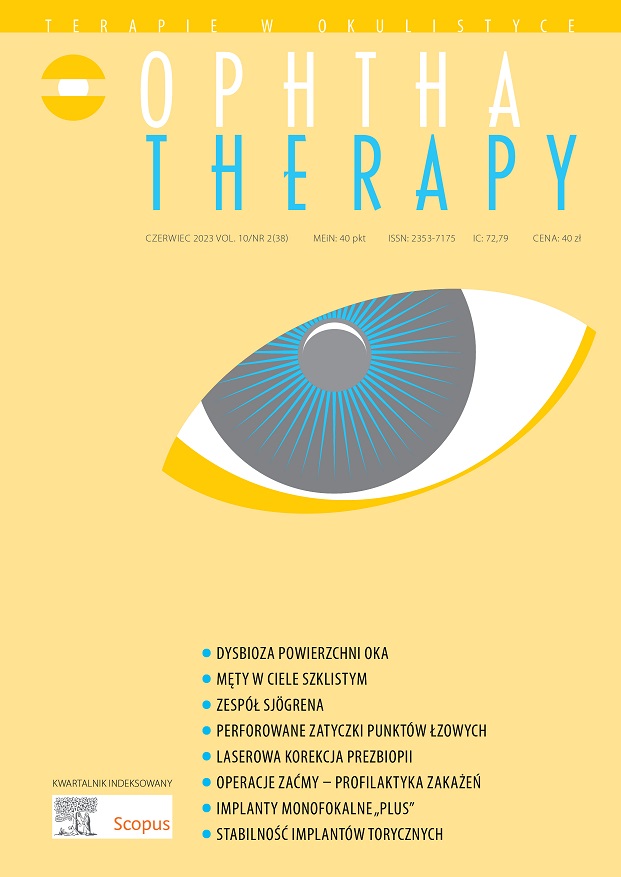Profilaktyka zakażeń po operacji zaćmy: fluorochinolony i leki przeciwzapalne – pojedynczo czy w preparatach złożonych? Artykuł przeglądowy
##plugins.themes.bootstrap3.article.main##
Abstrakt
Operacja zaćmy jest jedną z najczęściej wykonywanych procedur medycznych. Obecnie najczęściej stosowanymi lekami przeciwbakteryjnymi po zabiegach okulistycznych są moksyfloksacyna i lewofloksacyna. Spośród steroidowych leków o działaniu przeciwzapalnym powszechnie wykorzystuje się etabonian loteprednolu lub fosforan deksametazonu. Ze względu na to, że obecnie obowiązujące wytyczne po operacji zaćmy zalecają różne czasy stosowania fluorochinolonów (1–2 tygodnie) i glikokortykosteroidów (3–4 tygodnie), to wydaje się uzasadnione podawanie tych leków w oddzielnych preparatach obecnie dostępnych na rynku. Istnieje bowiem obawa, że stosowanie preparatów złożonych może spowodować zbyt długie przyjmowanie przez pacjenta fluorochinolonu, by utrzymane zostało przeciwzapalne działanie glikokortykosteroidów w miejscu operowanym, to zaś może doprowadzić do selekcji szczepów opornych i zwiększa ryzyko działań niepożądanych.
Pobrania
##plugins.themes.bootstrap3.article.details##

Utwór dostępny jest na licencji Creative Commons Uznanie autorstwa – Użycie niekomercyjne – Bez utworów zależnych 4.0 Międzynarodowe.
Copyright: © Medical Education sp. z o.o. License allowing third parties to copy and redistribute the material in any medium or format and to remix, transform, and build upon the material, provided the original work is properly cited and states its license.
Address reprint requests to: Medical Education, Marcin Kuźma (marcin.kuzma@mededu.pl)
Bibliografia
2. Alberth M, Winwood D, Bodor N. Lipophilicity, solubility and permeability of loteprednol etabonate: a novel, soft anti-inflammatory corticosteroid. J Biopharm Sci. 1991; 2(2): 115-25.
3. Samudre SS, Lattanzio FA Jr, Williams PB et al. Comparison of topical steroids for acute anterior uveitis. J Ocular Pharm Ther. 2004; 20: 533-47.
4. Chen Y, Wang X, Gao M et al. The effect of loteprednol suspension eye drops after corneal transplantation. BMC Ophthalmol. 2021; 21(1): 234.
5. Sheppard JD, Comstock TL, Cavet ME. Impact of the topical ophthalmic corticosteroid loteprednol etabonate on intraocular pressure. Adv Ther. 2016; 33(4): 532-52.
6. Gaballa SA, Kompella UB, Elgarhy O et al. Corticosteroids in ophthalmology: drug delivery innovations, pharmacology, clinical applications, and future perspectives. Drug Deliv Transl Res. 2021; 11(3): 866-93.
7. Sharma T, Kamath MM, Kamath MG et al. Aqueous penetration of orally and topically administered moxifloxacin. Br J Ophthalmol. 2015; 99(9): 1182-5.
8. Torkildsen G, Proksch JW, Shapiro A et al. Concentrations of besifloxacin, gatifloxacin, and moxifloxacin in human conjunctiva after topical ocular administration. Clin Ophthalmol. 2010; 4: 331-41.
9. Kim DH, Stark WJ, O’Brien TP et al. Aqueous penetration and biological activity of moxifloxacin 0.5% ophthalmic solution and gatifloxacin 0.3% solution in cataract surgery patients. Ophthalmology. 2005; 112(11): 1992-6.
10. Bucci FA Jr, Nguimfack IT, Fluet AT. Pharmacokinetics and aqueous humor penetration of levofloxacin 1.5% and moxifloxacin 0.5% in patients undergoing cataract surgery. Clin Ophthalmol. 2016; 10: 783-9.
11. Gomes RLR, Viana RG, Melo LAS Jr et al. Aqueous humor concentrations of topical fluoroquinolones alone or in combination with a steroid. Arq Bras Oftalmol. 2017; 80(5): 300-3.
12. Figus M, Posarelli C, Romano D et al. Aqueous humour concentrations after topical application of combined levofloxacin-dexamethasone eye drops and of its single components: a randomised, assessor-blinded, parallel-group study in patients undergoing cataract surgery: the iPERME study. Eur J Clin Pharmacol. 2020; 76(7): 929-37.
13. Solomon KD, Sandoval HP, Potvin R. Comparing combination drop therapy to a standard drop regimen after routine cataract surgery. Clin Ophthalmol. 2020; 14: 1959-65.
14. Emami S, Kitayama K, Coleman AL. Adjunctive steroid therapy versus antibiotics alone for acute endophthalmitis after intraocular procedure. Cochrane Database Syst Rev. 2022; 6(6): CD012131.
15. O’Neill J. Tackling Drug-Resistant Infections Globally: Final Report and Recommendations. Review on Antimicrobial Resistance. Wellcome Trust and HM Government . Online.
16. Kato A, Horita N, Namkoong H et al. Prophylactic antibiotics for postcataract surgery endophthalmitis: a systematic review and network meta-analysis of 6.8 million eyes. Sci Rep. 2022; 12(1): 17416.
17. Grzybowski A, Kupidura-Majewski K. Znaczenie kropli antybiotykowych w profilaktyce okołooperacyjnej zapalenia wnętrza gałki po operacjach zaćmy. OphthaTherapy. 2019; 6(3): 147-51.
18. Miller KM, Oetting TA, Tweeten JP et al.; American Academy of Ophthalmology Preferred Practice Pattern Cataract/Anterior Segment Panel. Cataract in the adult eye preferred practice pattern. Ophthalmology. 2022; 129(1): P1-P126.
19. Barry P, Cordovés L, Gardner S. ESCRS guidelines for prevention and treatment of endophthalmitis following cataract surgery: data, dilemmas and conclusions 2013. Online.
20. Iwasaki T, Nejima R, Miyata K. Ocular surface flora and prophylactic antibiotics for cataract surgery in the age of antimicrobial resistance. Jpn J Ophthalmol. 2022; 66(2): 111-8.
21. Rizzo S, Gambini G, De Vico U et al. A one-week course of levofloxacin/dexamethasone eye drops: a review on a new approach in managing patients after cataract surgery. Ophthalmol Ther. 2022; 11(1): 101-11.
22. Nowakowska D, Krix-Jachym K, Rękas M et al. Antibiotic resistance in ophthalmology. Ophthalmol J. 2021; 6: 117-23.

